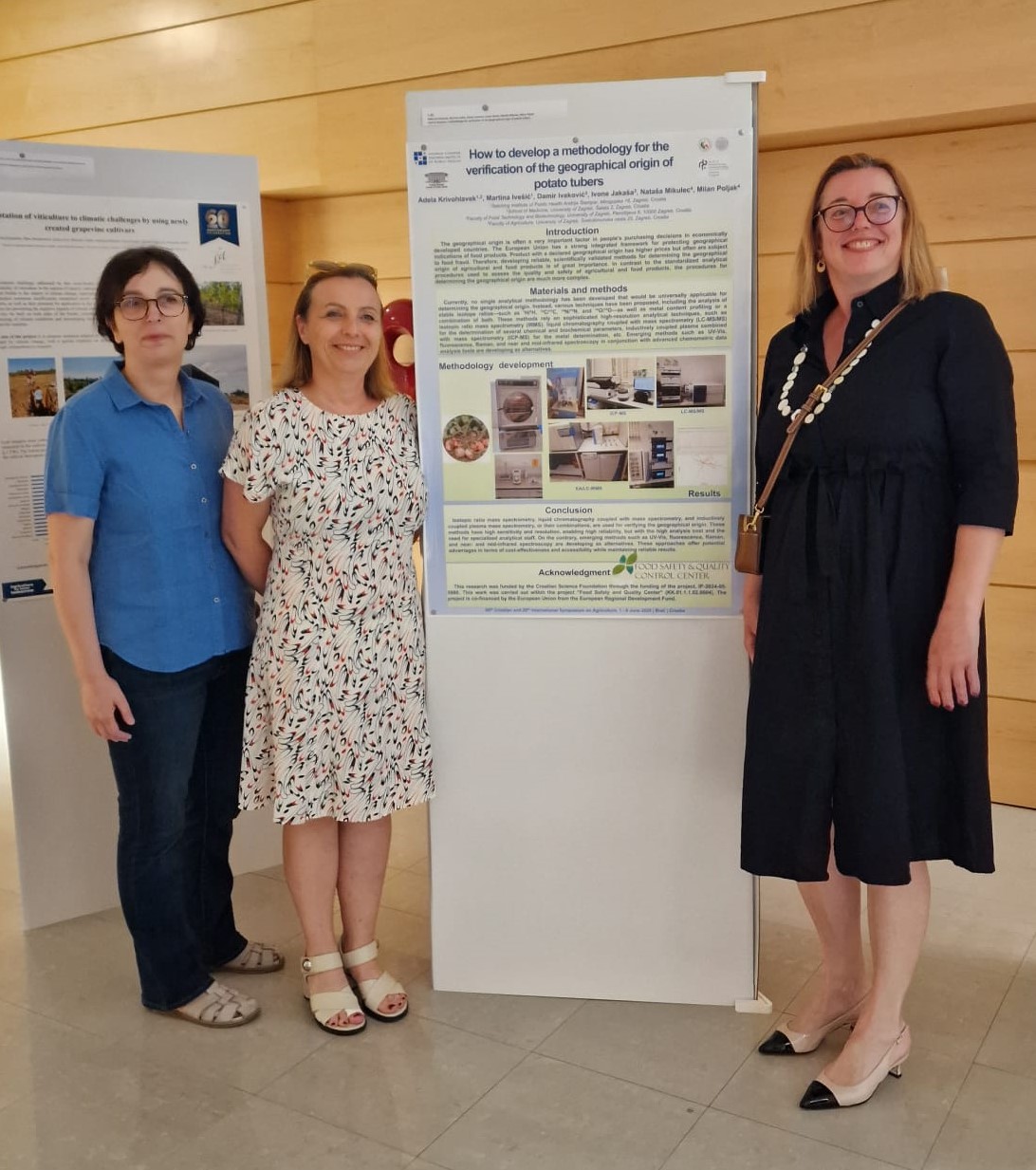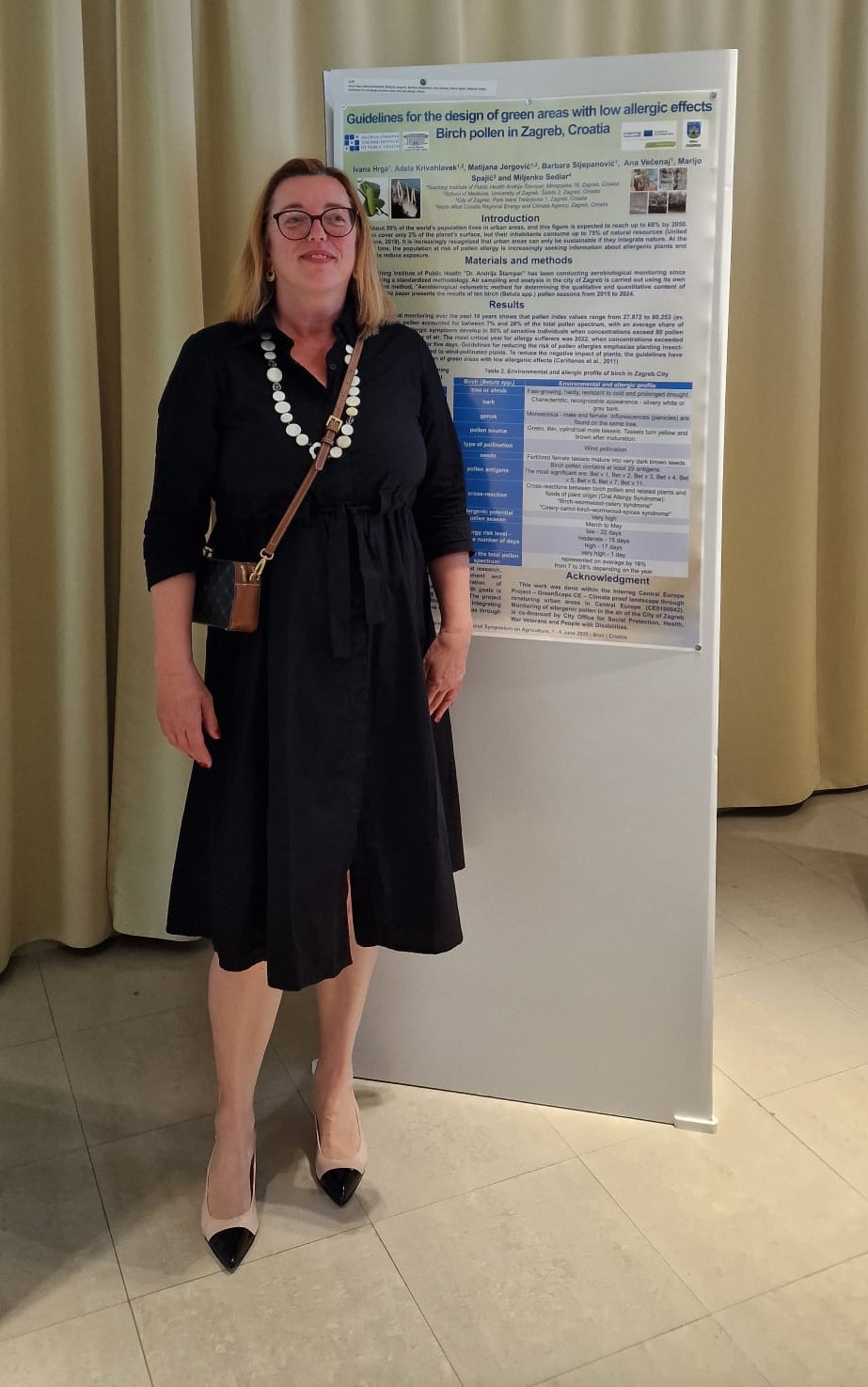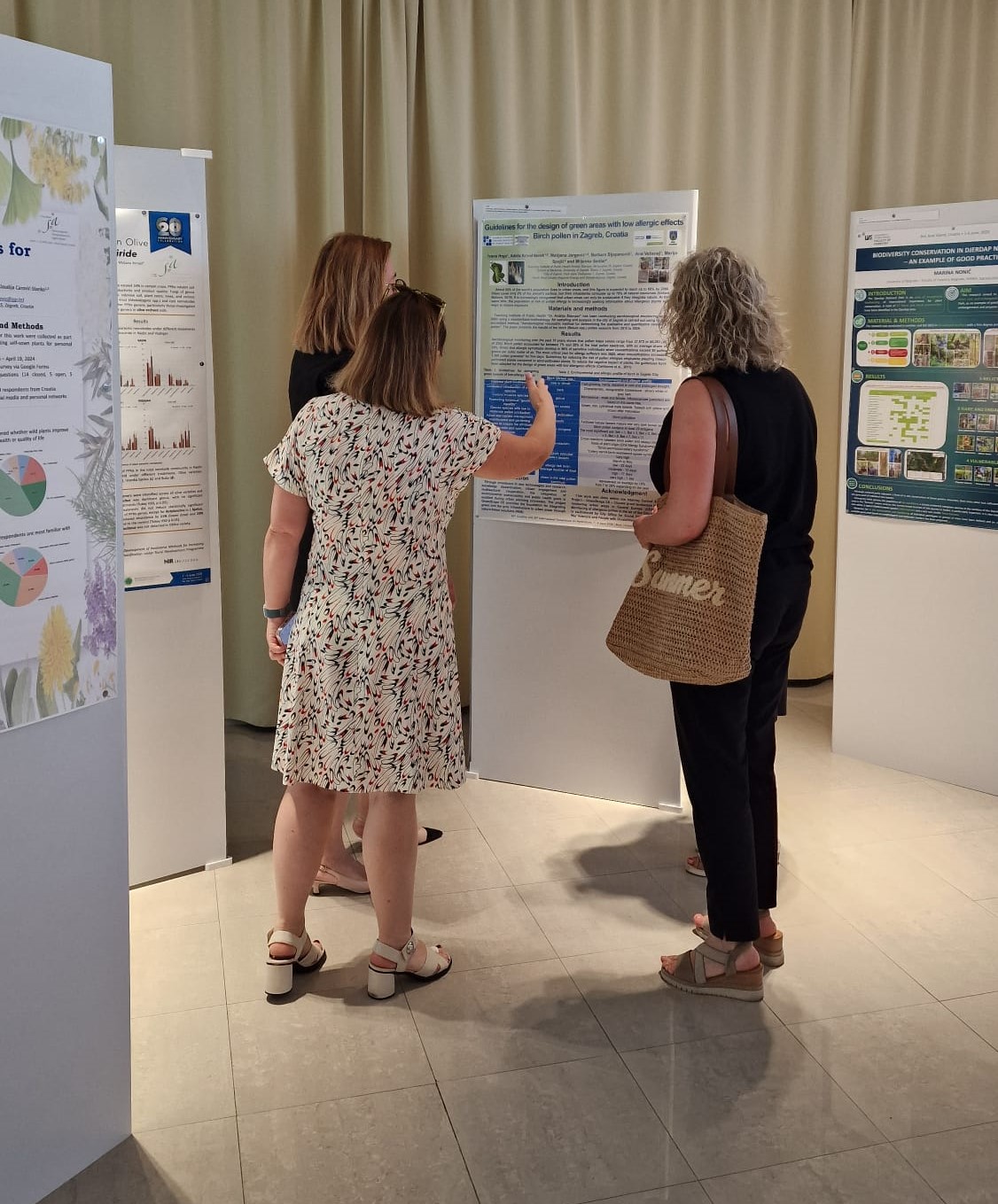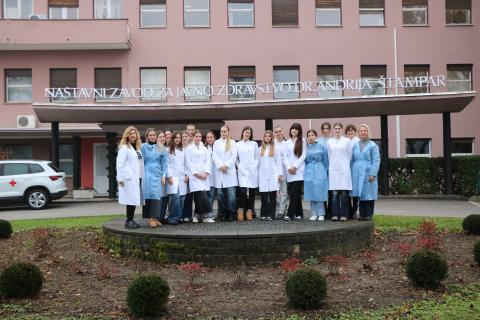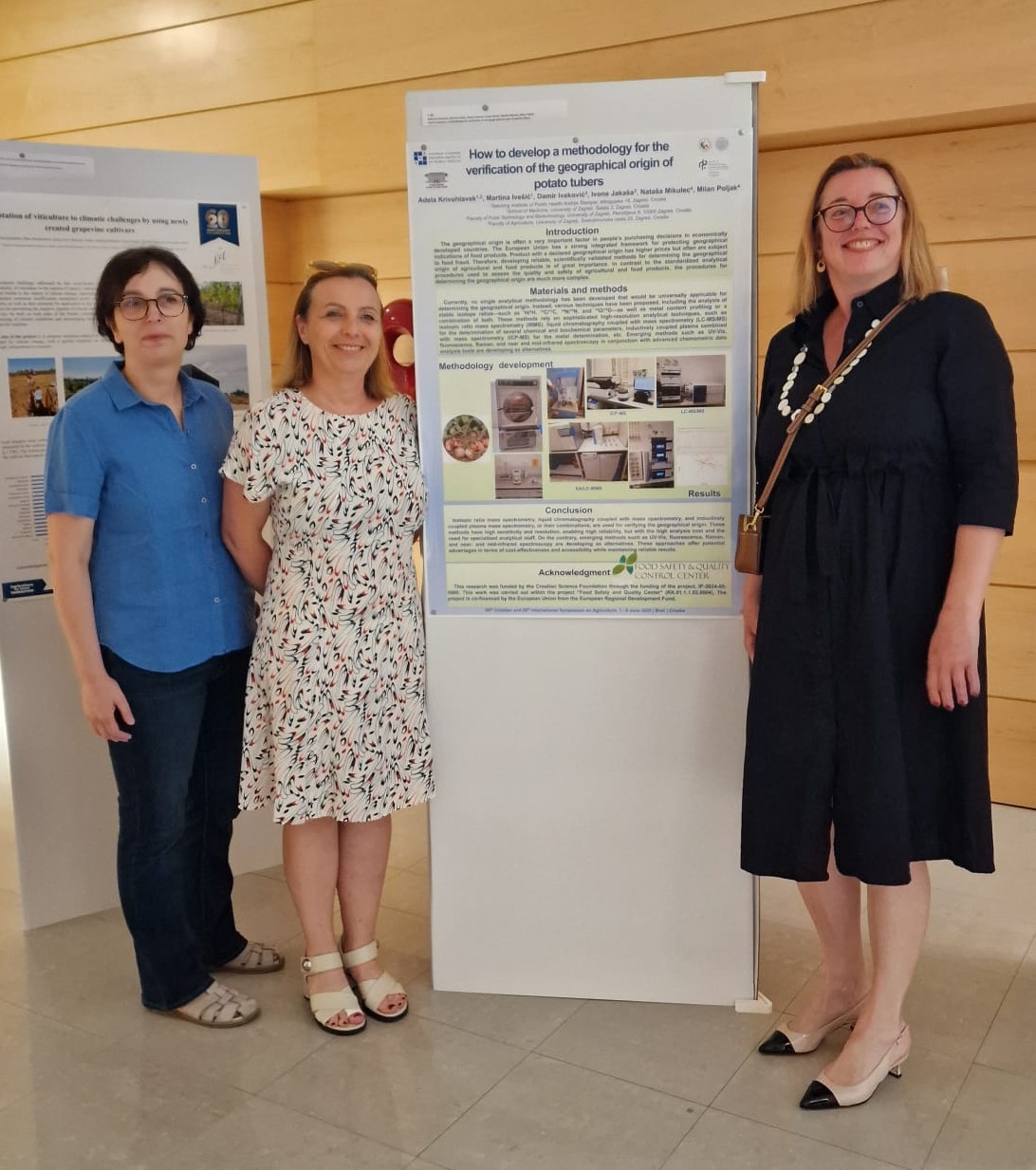
U razdoblju od 1. do 6. lipnja 2025. u Bolu na Braču održan je 60. hrvatski i 20. međunarodni simpozij agronoma. Organizatori su bili Agrobiotehnički fakultet Sveučilišta Josipa Jurja Strossmayera iz Osijeka i Agronomski fakultet Sveučilišta u Zagrebu, uz suorganizatore. Djelatnici Centra za sigurnost i kvalitetu hrane predstavili su se s nekoliko poster priopćenja koja prikazuju rezultate aktivnosti koje se provode kroz potprojekte Centra. Program Simpozija obuhvaćao je teme biljne i animalne proizvodnje, agroekologije, agrobiznisa i digitalne poljoprivrede, raspoređene u šest cjelina. Znanstvenici Centra aktivno su sudjelovali s izlaganjima rezultata svojih istraživanja i na taj način pridonijeli razmjeni znanja i stručnim raspravama.
Sažeci postera:
U kategoriji Plant and Food Production u sklopu Projekta Razvoj metodologije za dokazivanje zemljopisnog porijekla i konvencionalnog/ekološkog uzgoja krumpira prikazan je poster How to develop a methodology for the verification of the geographical origin of potato tubers.
How to develop a methodology for the verification of the geographical origin of potato tubers
Adela Krivohlavek1,2, Martina Ivešić1, Damir Iveković3, Ivone Jakaša3, Nataša Mikulec4, Milan Poljak4
1Teaching Institute of Public Health Andrija Štampar, Mirogojska 16, Zagreb, Croatia
2School of Medicine, University of Zagreb, Šalata 2, Zagreb, Croatia
3Faculty of Food Technology and Biotechnology, University of Zagreb, Pierottijeva 6, 10000 Zagreb, Croatia
4Faculty of Agriculture, University of Zagreb, Svetošimunska cesta 25, Zagreb, Croatia
Summary
The geographical origin is often a very important factor in the purchasing decisions of people in economically developed countries. The European Union has a strong integrated framework for protecting geographical indications of food products. Product with declared geographical origin has higher prices but often are subject to food fraud. Therefore, developing reliable, scientifically validated methods for determining the geographical origin of agricultural and food products is of great importance. In contrast to the standardized analytical procedures used to assess the quality and safety of agricultural and food products, the procedures for determining the geographical origin are much more complex. Currently, no single analytical methodology has been developed that would universally be applicable for determining the geographical origin. Instead, various techniques have been proposed, including the analysis of stable isotope ratios—such as ¹H/²H, ¹²C/¹³C, ¹⁴N/¹⁵N, and ¹⁶O/¹⁸O—as well as metal content profiling or a combination of both. These methods rely on sophisticated high-resolution analytical techniques, such as isotopic ratio high-resolution mass spectrometry (IRMS), liquid chromatography coupled with mass spectrometry for the determination of several chemical and biochemical parameters, inductively coupled plasma combined with mass spectrometry (ICP-MS) for the metal determination, etc. Due to their high sensitivity and resolution, these methods enable high reliability with the high cost of analysis and specialized analytical staff. Emerging methods such as UV-Vis, fluorescence, Raman, and near and mid-infrared spectroscopy are developing as alternatives. These approaches offer potential advantages in terms of cost-effectiveness and accessibility while maintaining reliable results.
Key words: agricultural and food products, geographical origin, IRMS, ICP-MS, LC-MS/MS
Acknowledgment
This research was funded by the Croatian Science Foundation through the funding of the project, IP-2024-05-5900. This work was carried out within the project “Food Safety and Quality Center” (KK.01.1.1.02.0004). The project is co-financed by the European Union from the European Regional Development Fund.
Animal Production and Food Quality
Agroecology and Regenerative Agriculture
U kategoriji Biodiversity Conservation u sklopu projekta Interreg Central Europe Project – GreenScape CE – Climate proof landscape through renaturing urban areas in Central Europe (CE0100042), prezentiran je rad Guidelines for the design of green areas with low allergic effects Birch pollen in Zagreb.
Guidelines for the design of green areas with low allergic effects
Birch pollen in Zagreb, Croatia
Ivana Hrga1, Adela Krivohlavek1,2, Matijana Jergović1,2, Barbara Stjepanović1, Ana Večenaj1, Marijo Spajić3 and Miljenko Sedlar4
1Teaching Institute of Public Health Andrija Štampar, Mirogojska 16, Zagreb, Croatia
2University of Zagreb, School of Medicine, Šalata 2, Zagreb, Croatia
3City of Zagreb, Park stara Trešnjevka 1, 10 000 Zagreb, Croatia
4North West Croatia Regional Energy and Climate Agency, Zagreb, Croatia
Abstract
Nowadays, the population at risk of pollen allergy is increasingly seeking information about allergenic plants and ways to reduce exposure. Aerobiological monitoring over the past 10 years of the city of Zagreb shows that pollen index values range from 27.872 to 80.253 (av. 47.255). The contribution percentage of birch pollen in the total pollen spectrum is up to 16 %.
Investment in research and knowledge dissemination activities, including multidisciplinary collaboration and a citizen engagement approach, emphasizes the need to integrate environmental sustainability with public health aspects and urban planning. Guidelines for reducing the risk of pollen allergies emphasize planting insect-pollinated plants compared to wind-pollinated plants. Also, the guidelines include: plant biodiversity enhancement, controlled introduction of exotic or/and invasive species, botanical “gender equality” promotion, low to moderate pollen production species selection, the introduction of management, maintenance, and gardening strategies to ensure the removal of opportunistic and spontaneous species, pollen hotspot prevention, and information based, spatially personalized species selection with reduced cross-reaction risk in line with legal framework strengthening regarding the design and planning of urban green spaces.
The project "Climate-proof landscape through renaturing urban areas in Central Europe - GreenScape CE" provides the foundation for integrating green into the gray infrastructure in urban areas through nature-based solutions (NbS).
Key words: aerobiological monitoring, allergy, biodiversity, guidelines, nature-based solutions
Acknowledgement
This work was done within the Interreg Central Europe Project – GreenScape CE – Climate proof landscape through renaturing urban areas in Central Europe (CE0100042). Monitoring of allergenic pollen in the air of the City of Zagreb is co-financed by City Office for Social Protection, Health, War Veterans and People with Disabilities.
